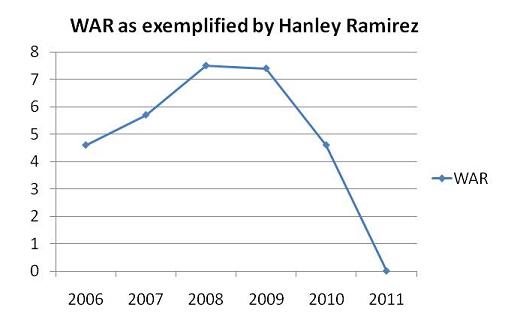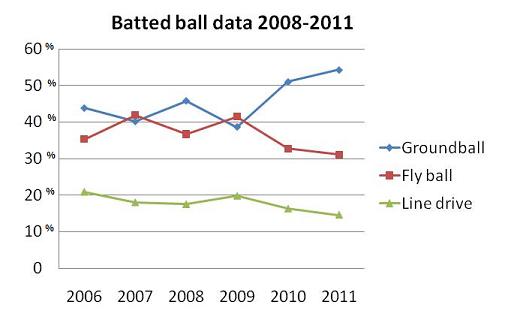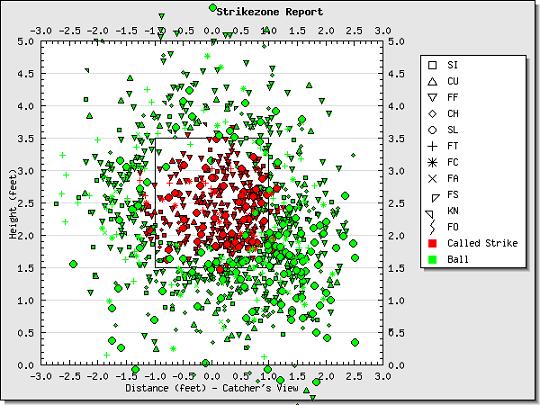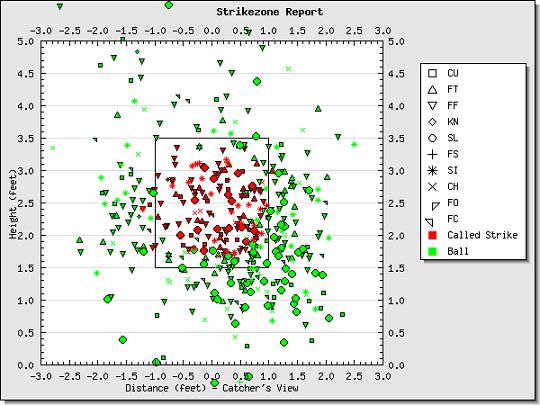Hanley Ramirez and the 2011 season reboot
Things were expected to be better for Hanley Ramirez as he began his 2011 season. Still in the early part of his age 27 season, Ramirez has all the tools that are essential when great players are judged.
He has displayed above-average speed and power, and has the contact skills necessary to produce a .300-plus batting average while also manning one of the more demanding positions on the field. Since his debut in 2006, Ramirez has put up a career line of .307/.380/.508 with an impressive weighted on-base average (wOBA) of .386. But this season, things have been dreadful as Ramirez has struggled at the plate to the tune of .206/.302/.307 along with an equally alarming .279 wOBA as we approach the mid-point in June.
Before being included as a key piece in the Josh Beckett trade, Ramirez was a promising middle infielder in the Boston Red Sox organization. Playing with the Double-A Portland Sea Dogs in 2004, Ramirez showed excellent promise as a 20-year-old by hitting .310/.360/.512 in 139 plate appearances. This brief display wasn’t too surprising since he had occupied the upper tiers of Red Sox prospect lists since signing as an international free agent in 2000.
Before the 2005 season, he was recognized by Baseball America as the 10th best prospect in baseball but issues of immaturity coupled with an offensive backslide reduced his value a bit. Called out for his lack of focus and commitment, Ramirez was suspended on a few occasions for minor infractions . It was a lingering sense that his character development might never catch up to his physical abilities that made the Red Sox’ decision to trade him easy.
As of today, the trade has helped both sides, Beckett went on to help the Sox win the World Series in 2007 and is still a valuable member of their rotation. Ramirez became one of top young stars in the game. Maybe he wouldn’t dazzle you defensively (UZR/150 seems a bit disappointing based on his -9.3 total) but his bat has been more than enough to pull his WAR (wins above replacement) to something resembling asSuperstar.

But as this chart trends downward, we would be remiss to not mention a few nagging concerns.
Too many ground balls
The first 200 plate appearances of Hanley Ramirez in 2011 have been well documented and one thing we can all agree on: Ramirez is hitting far too many ground balls.

As we can see, this “groundball problem” isn’t just a 2011 phenomenon; it surfaced last season. Looking at his 2010 splits, Ramirez had a very high 61.3 percent groundball rate in April. In July of 2010, it was still high at 53.2 percent but it would trend downward until he was hitting ground balls at the low rate of 36.8 percent in September.
Building upon the work done by David Golebiewski and Dave Allen at RotoGraphs, here are some updated batted ball trends in terms of basic pitch types from 2008 till now.
| 2008-2009 | GB% | FB% | LD% |
| Fastball | 41.8 | 39.8 | 18.4 |
| Slider | 43.2 | 35.6 | 21.2 |
| Curveball | 45.3 | 38.3 | 16.4 |
| Changeup | 41.4 | 31.5 | 27.1 |
| 2010-2011 | |||
| Fastball | 53.1 | 30.5 | 16.4 |
| Slider | 50.9 | 32.4 | 16.7 |
| Curveball | 56.6 | 31.2 | 12.2 |
| Changeup | 51.3 | 33.6 | 15.1 |
Compared to the current major league averages provided by Harry Pavlidis:
| 2011 MLB Avg. | GB% | FB% | LD% |
| Fastball | 42 | 30 | 20 |
| Slider | 45 | 29 | 17 |
| Curveball | 50 | 25 | 19 |
| Changeup | 49 | 26 | 18 |
As you can see, there has been a drastic increase in his groundball output from last season coming from the majority of pitch types. Looking at a few of the off-speed types between 2010 and ’11 there have been some positives emerging. In 2010 Ramirez struggled to get any lift on the change-up, So far this season he has adjusted, going from a flyball rate of 21.1 percent in 2010 to 46.7 percent this season. Ramirez has also seen an uptick in fly balls off curveballs, going from 23.4 percent last season to 38.5; however, they seem to have come at the expense of his line drive rate as this key stat has plummeted from a healthy 23.8 percent last season to 7.7 percent this season.
| PA | BB% | K% | ISO | BABIP | wOBA | |
| 2006 | 700 | 8 | 20.2 | .188 | .343 | .364 |
| 2007 | 706 | 7.4 | 14.9 | .230 | .353 | .411 |
| 2008 | 693 | 13.3 | 20.7 | .239 | .329 | .405 |
| 2009 | 652 | 9.4 | 17.5 | .201 | .379 | .41 |
| 2010 | 619 | 10.3 | 17.1 | .175 | .327 | .373 |
| 2011 | 216 | 11.6 | 19.6 | .101 | .236 | .279 |
In the above chart, it’s hard to not notice the precipitous decline in his isolated power score (ISO) as well as the curious drop in his BABIP, which is interesting given his sharp decline in fly ball output but his further drop in line drives could also play a part.
His walks have remained consistent while his strikeouts are up a few percentage points from the previous two season. Still, they haven’t reached any career highs.
One thing I haven’t mentioned is Ramirez’s health, which may become a big issue. This season, his back has become bothersome, requiring a stay on the disabled list at the beginning of this month. According to reports, the stiffness he felt in his back has been an on and off issue but was mentioned only when the pain became overwhelming before a May 29 game at Dodger Stadium.
Since many of the problems plaguing Ramirez—reduction in power and steady increase of ground balls—are a carryover from last season, it’s possible to see this connected to health. Last season, he was hampered by a sore elbow and shut down after the third week in September. As of this writing, Ramirez has said that his back feels much better and the original symptoms that were a cause for alarm have seemingly gone away.
But what will this mean for someone who has gained the reputation for taking conditioning lightly over the offseason?
Exit John Mallee, enter new hitting coach Eduardo Perez
Earlier this season, Ramirez alternated between a wide open and closed batting stance. Coming back from the DL, it seems he is leaning toward an open stance.
Changing his batting stance isn’t new. Before the 2009 season, when it was announced that Ramirez would bat third after his first few seasons in the leadoff spot. we saw a change from his original toe tap to his now high leg kick.
Before being named Marlins hitting coach last season, John Mallee enjoyed a long career as their minor league hitting coordinator. I’m not privy to any actual statements connecting Mallee’s firing with Ramirez’s struggles, but it has been suggested around the internet that these are related.
Reading between the lines, it probably isn’t much of a stretch to see that Mallee’s meticulousness and mechanical approach to hitting may be a little too serious for Ramirez and his borderline improvisational attitude towards each pitcher. Funny how new hitting coach Eduardo Perez is currently being praised for his ability to “adjust to other players” and promising to work with each player on an individual basis. Don’t get me wrong, that’s probably the best approach to take among established player,s but one has to question if that would be best for the Marlins, the third youngest team in baseball.
Conclusion
Since it’s way too early to call what’s happening to Hanley Ramirez as a decline, one has to question the approach Ramirez is taking (or not taking) as opposing pitchers have adjusted to him. Looking over location charts provided by Joe Lefkowitz, we can see that opposing pitchers have been pounding the outside part of the plate against Ramirez:
2010 location

2011 location (as of June 15)

And looking at batted ball data by location we can see that most of Ramirez’ ground balls come when he connects on outside pitches. Healthy or not, this will be a problem Ramirez needs solve or that six-year, $70 million dollar extension that runs through 2014 will get old real fast.
